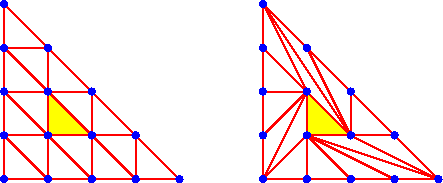 |
| Figure 2: Regular and non-regular triangulations |



The combinatorial structure underlying the homotopy algorithm of
Huber and Sturmfels is that of a regular triangulation, which
is a special case of a regular subdivision.
A regular subdivision Pw of a lattice polytope
P is given by a lifting function
In Figure 2 the triangulation on the left is regular and the triangulation on the right is not regular. Consider a hypothetical lifting function w for the triangulation on the right. We assume that w takes the value 0 at the three interior vertices. The clockwise neighbour of any vertex of the big triangle must be lifted higher than that vertex. (Consider the figure they form with the parallel edge of the interior triangle.) Since the edge of the big triangle is lifted to a concave broken path, this implies that each vertex is lower than its clockwise neighbour, which is impossible, except in some M.C. Escher woodcuts.


